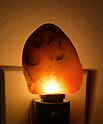
Back عقيق لحمي Arabic Аҡыҡ Bashkir Карнеол Byelorussian Карнелиан Bulgarian Kornalin Breton Cornalina Catalan Karneol Czech Krwawnik CSB Карнеол CV Karneol Danish
| Carnelian | |
|---|---|
 | |
| General | |
| Category | Chalcedony variety |
| Formula (repeating unit) | SiO2 (silicon dioxide) |
| Crystal system | Trigonal |
| Identification | |
| Formula mass | 60 g/mol |
| Color | Reddish, orange, brownish |
| Cleavage | Absent |
| Fracture | Uneven, splintery, conchoidal |
| Mohs scale hardness | 6.5–7.0 |
| Luster | Waxy to resinous |
| Streak | White |
| Diaphaneity | Translucent to opaque |
| Specific gravity | 2.58–2.64 |
| Optical properties | Uniaxial + |
| Refractive index | 1.535–1.539 |
| Birefringence | 0.003–0.009 |
| References | [1][2] |
Carnelian (also spelled cornelian)[3] is a brownish-red mineral commonly used as a semiprecious stone. Similar to carnelian is sard, which is generally harder and darker; the difference is not rigidly defined, and the two names are often used interchangeably. Both carnelian and sard are varieties of the silica mineral chalcedony colored by impurities of iron oxide. The color can vary greatly, ranging from pale orange to an intense almost-black coloration. Significant localities include Yanacodo (Peru); Ratnapura (Sri Lanka); and Thailand.[2] It has been found in Indonesia, Brazil, India, Russia (Siberia), and Germany.[citation needed] In the United States, the official State Gem of Maryland is also a variety of carnelian called Patuxent River stone.[4]

- ^ Rudolf Duda and Lubos Rejl: Minerals of the World (Arch Css, 1990)
- ^ a b Carnelian on Gemdat.org
- ^ Agnes, Michael, ed. (2001). Webster's New World College Dictionary (4th ed.).
- ^ "Maryland State Gemstone: Patuxent River Stone (Agate)".
© MMXXIII Rich X Search. We shall prevail. All rights reserved. Rich X Search